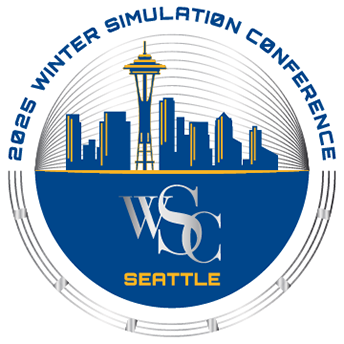Since its inception in 2022 as the “Case Study Competition,” the Winter Simulation Conference (WSC) Simulation Challenge has consistently emphasized the vital role of simulation in bridging the gap between academia and industry. This initiative is rooted in fostering interdisciplinary collaboration, driving innovation, and addressing real-world challenges through advanced simulation technologies.
For 2025, aligned with the WSC theme “Look to the Future! Simulation 2050 and Beyond.” The challenge will focus on the transformation of the maritime industry, particularly in the areas of port operations and cargo logistics. As global trade increasingly depends on complex maritime logistics networks, this year’s challenge invites participants (teams) to unleash their creativity in designing, optimizing, and evaluating dynamic port systems. The aim is to develop solutions that address the evolving needs of the maritime industry over the coming decades.
A Call for Innovation in Maritime Simulation
With ports around the world facing challenges such as climate change, transportation efficiency, energy transitions, and intelligent infrastructure management, simulation stands to play a pivotal role in shaping smarter, greener, and more efficient port ecosystems. The 2025 Simulation Challenge calls for innovative simulation applications that anticipate the future needs of port operations. Participants are encouraged to explore cutting-edge techniques, including the use of digital twin technologies for system optimization, AI-driven automation and scheduling for cargo handling, and the development of collaborative resource allocation platforms that enhance both operational efficiency and sustainability.
We are excited to announce that the 2025 Simulation Challenge is co-organized by the Department of Industrial Systems Engineering and Management (ISEM) at the National University of Singapore (NUS) and the Department of Engineering at the University of Exeter (United Kingdom), showcasing the global and interdisciplinary nature of this event.
Why Participate?
This competition offers participants a unique opportunity to engage with industry leaders, gain recognition for their innovative contributions, and compete for prestigious awards. Participants will also have an opportunity to present their solutions at the conference, showcasing their work to key professionals in the maritime sector and gaining valuable recognition. Through this challenge, we aim to inspire the next generation of simulation professionals to shape the future of maritime operations, looking ahead to 2050 and beyond.
Special Thanks to our Executive Simulation Challenge Sponsor
Signature Simulation Challenge Sponsors
Problem Description
The 2025 Simulation Challenge continues its focus on maritime logistics, addressing a complex and dynamic problem in cargo port operations. This year’s challenge centers on optimizing the interactions and operations within a cargo port, spanning processes from ship berthing to container handling and the management of Automated Guided Vehicle (AGV). Participants are invited to propose innovative and effective solutions that enhance port operational efficiency through simulation and optimization.
With the growing effectiveness of artificial intelligent (AI), the challenge encourages participants to go beyond traditional rule-based policies. The competition promotes the integration of optimization algorithms and reinforcement learning (RL) techniques to drive innovation and develop effective solutions.
To support participants (teams), the organizers will provide a base simulation model using discrete-event simulation (DES) method, implemented within o2despy, an open-source DES framework. A comprehensive document will be available, outlining the model structure through a rigorously defined formalism to ensure clarity and accessibility.
A dedicated “Decision-Maker” module will simulate a control interface, allowing participants to issue decisions without needing to fully parse the underlying simulation model or code. This allows participants to extract relevant simulation data, develop strategic policies, and enhance these strategies using optimization and machine learning-based techniques.
Competition Objective
Participants are required to refine the decision-making modules within the provided simulation model to improve cargo port efficiency. The goal is to optimize key performance indicators based on a variety of scenarios provided by the input data, streamline operational workflows, alleviate bottlenecks, and enhance resilience in the face of external challenges such as unpredictable shipping schedules or resource shortages/constraints.
Key Areas for Decision Module Enhancement
Participants are expected to focus on the following critical decision variables:
- Anchorage Departure Sequencing: Prioritizing vessel departure from the designated waiting area to berth (No need to follow the arrival sequence).
- Berth allocation: Efficiently allocate berths to incoming vessels, considering arrival times and departure schedules.
- Yard block allocation: Decide on the best yard block for storing containers discharged from vessels, balancing space utilization and efficiency.
- AGV assignment: Strategically assign AGVs to discharge and load tasks, ensuring timely and coordinated cargo movement.
Required Deliverables
Participants are required to:
- Design and implement a control or decision-making system that minimizing total time (waiting + service).
- Participants are encouraged to:
- Modify or enhance the provided demo modules (default, decision_maker_heuristic, decision_maker_learning) freely.
- Propose entirely new approaches or algorithms independent of the provided demo modules.
- Make modifications to any part of the project (init, learning, etc.), as long as the simulation logic and integrity remain intact.
- Insert additional interfaces or hooks into the simulation model, provided these do not disrupt existing logic.
- Participants must ensure their submitted project:
- Runs seamlessly without errors.
- Clearly documents the implemented approach and modifications made to the original codebase.
- Submit the complete project and experiment results, clearly labeled and structured for ease of evaluation, ensuring the project can be executed without additional dependencies.
Evaluation
During this evaluation stage, the pre-specified undisclosed scenarios and random seeds will serve as the input of the programs. The organizers will then execute each participant’s simulation program and record the output of performance index values. These outputs will form the basis for scoring and final rankings. Projects will be judged solely based on their ability to achieve the shortest possible total time (waiting + service) while maintaining the integrity of the simulation logic.
- The competition is structured into four successive rounds. As the competition progresses, the weighting assigned to each round increases in proportion to the complexity of the respective scenario.
- The first three rounds will take place over a three-month period from August to October. For each of these rounds, a new scenario will be released at the beginning of every month (refer to the schedule for details). Participants (teams) may submit their work for each round at any point of time before the 23rd of each respective month. Resubmissions are allowed, provided they are made before the deadline of each round. Throughout this period, there will be a dynamic leaderboard which ranks the performance of the submissions we receive. This ranking will be regularly updated as the submissions are evaluated, with the final standings for each round published at the end of the month.
- For each round, teams will be awarded some points. The top ten teams will get points on a descending scale of 100, 95, 90, and so on, down to 55 points. All other teams that submit a valid model will be awarded 50 points.
- Each round carries a different weight. Specifically, the weights assigned to Rounds 1 to 4 are 0.05, 0.15, 0.3, and 0.5, respectively. Final rankings will be determined based on the weighted sum of points accumulated across all rounds.
- For example, if a team places 5th in both Rounds 1 and 2, and 2nd in Round 3, and 1st in Round 4, their corresponding points would be calculated as follows: (80×0.05) + (80×0.15) + (95×0.3) + (100×0.5) = 94.5.
- Unlike previous rounds, the scenario for the final round will not be released. Teams (participants) may choose to submit an updated version of their work for this round or re-submit any of their previous works. All final submissions must be received by 23rd Please note that the leaderboard will not be publicly published for this round.
- The teams’ performance in every round will contribute towards their overall results, which will be announced on 30th
- The Top 5 finalists will be invited to prepare a report presentation for the WSC2025, and the top 6-10 participants (teams) are encouraged to present their work on-site during the event.
Timeline
The competition officially starts on August 1 with the start of Round 1.
Round 1
Start Date: August 1
- Registration opens
- Case study is announced
- First Scenario is released
- Submissions for Round 1 open
End Date: August 23
Submissions close for the Round 1.
Evaluation Period: August 24-30
Rankings Announcement: August 31
Round 2
Start Date: September 1
- New Scenario is released
- Submissions for Round 2 open
End Date: September 23
Submissions close for the Round 2.
Evaluation Period: September 24-29
Rankings Announcement: September 30
Round 3
Start Date: October 1
- New Scenario is released
- Submissions for Round 3 open
End Date: October 23
Submissions close for the Round 3.
Evaluation Period: October 24-30
Rankings Announcement: October 31
Hidden Round
Start Date: November 1
- Submissions for Hidden Round open
- No new scenario will be released
- Participants can either:
- submit an updated version of their work OR
- re-submit their previous works
End Date: November 23
Submissions close for the Hidden Round.
Evaluation Period: November 24-29
Rankings Announcement: November 30
Top 5 teams announced.
Rules & Registration
Eligibility
To be eligible to enter the competition, all participants must:
- Register for the competition with a valid and active email address which the organizer can use to communicate with the participants.
- Either be a single entrant or part of a team of up to a maximum of five (5) members only. Each participant can only join up to one team.
- Be solely responsible for creating the competition submission. Supervision or advice from the participants’ professors or post-doctoral researchers is permissible.
The competition is open to all except for members of the committee, including all staff members. However, the committee reserves the right to approve or disapprove participation according to its own considerations.
Please download the Registration Document, fill in the relevant content and rename the document to “Registration +Team Name”, and send it to [email protected] to complete the registration.
Submission
Please submit your code in .rar or .zip file. The file name is Round Number + Team Name, eg Round1_TeamN. Make sure you have tested the code in your local computer.
Email address for submission: [email protected]
Prizes
Total Prize Amount (USD): $10,000
- 1st place: $2,000 + $475 registration fee
- 2nd & 3rd places: $1,000 + $475 registration fee
- 4th & 5th places: $500 +$475 registration fee
- 6th to 10th places: $475 registration fee (if attending the conference)
Please Note: We reserve five registration fee reimbursements for any participants who wish to present their work onsite at the WSC2025. These reimbursements are available even to those who are not among the top five finalists, provided they present their work at the conference. Only participants who attend the WSC2025 conference in person will be eligible to receive their ranking certificates and prize money. Participants who do not attend the conference in person will instead be awarded a “Successful Participation Award” in recognition of their effort. 1st place – 5th place winners will need to provide appropriate tax documentation (foreign payees: W-8 ENE and for US payees: W-9).
Contact
For any enquiries, please feel free to drop our Case Competition Chair, Dr. Li Haobin, an email at [email protected] and Co-Chair, Dr. Martino Luis, [email protected]
Terms & Conditions
- The competition committee reserves the right to disqualify any entrant from the competition if, in the competition committee’s sole discretion, it reasonably believes that the entrant has attempted to undermine the legitimate operation of the competition through cheating, deception, or other unfair playing practices.
- Submissions are void if they are in whole or part illegible, incomplete, damaged, altered, counterfeit, obtained through fraudulent means, or late. The competition committee reserves the right, in its sole discretion, to disqualify any entrant who makes a submission that does not adhere to all requirements.
- Officers, directors, employees, and advisory board members (and their immediate families and members of the same household) of the competition organizer and their respective affiliates are not eligible to participate in the competition.
- You agree to use reasonable and suitable measures to prevent persons who have not formally agreed to these rules from gaining access to the software and data provided by the competition organizer. You agree not to transmit, duplicate, publish, redistribute, or otherwise provide or make such software and data available to any party not participating in the competition. You agree to notify the competition organizer immediately upon learning of any possible unauthorized transmission or unauthorized access of such software and data and agree to work with the competition organizer to rectify any unauthorized transmission. You agree that participation in the competition shall not be construed as having or being granted a license (expressly, by implication, or otherwise) under, or any right of ownership in, any of the software and data.
- By downloading the software and data provided by the competition organizer you agree to the following terms:
- You will not distribute the software and data.
- You accept full responsibility for your use of the software and data and shall defend and indemnify the competition organizer, against any claims arising from your use of the software and data.
- By joining the competition, you affirm and acknowledge that you agree to comply with applicable laws and regulations, and you may not infringe upon any copyrights, intellectual property, or patent of another party for the software you develop in the course of the competition, and will not breach of any applicable laws and regulations related to export control and data privacy and protection.
- The competition committee reserves the right to verify eligibility and to adjudicate on any dispute at any time. If you provide any false information relating to the competition concerning your identity, residency, mailing address, telephone number, e-mail address, right of ownership, or information required for entering the competition, you may be immediately disqualified from the competition.
- The winner’s codes and documentation (collectively referred to as “program”) will be kept on the competition website after the competition. Unless otherwise indicated, all copyrights of the program belong to the winner. The program is licensed under MIT license. THIS PROGRAM IS PROVIDED ON AN “AS IS” BASIS, WITHOUT WARRANTIES OF ANY KIND, EITHER EXPRESS OR IMPLIED, INCLUDING BUT NOT LIMITED TO NON-INFRINGEMENT, MERCHANTABILITY OR FIT FOR A PARTICULAR PURPOSE.
- Prizes are subject to the competition committee’s review and verification of the entrant’s eligibility and compliance with these rules as well as the compliance of the winning submissions with the submission requirements.
- Competition prizes do not include tax payment. Any potential winner is solely responsible for all applicable taxes related to accepting the prize.
- The competition committee reserves the right at its sole discretion to terminate, modify, or suspend the competition, or disqualify the participants from the competition.
- For more information about personal data protection, please refer to the Privacy Policy.



